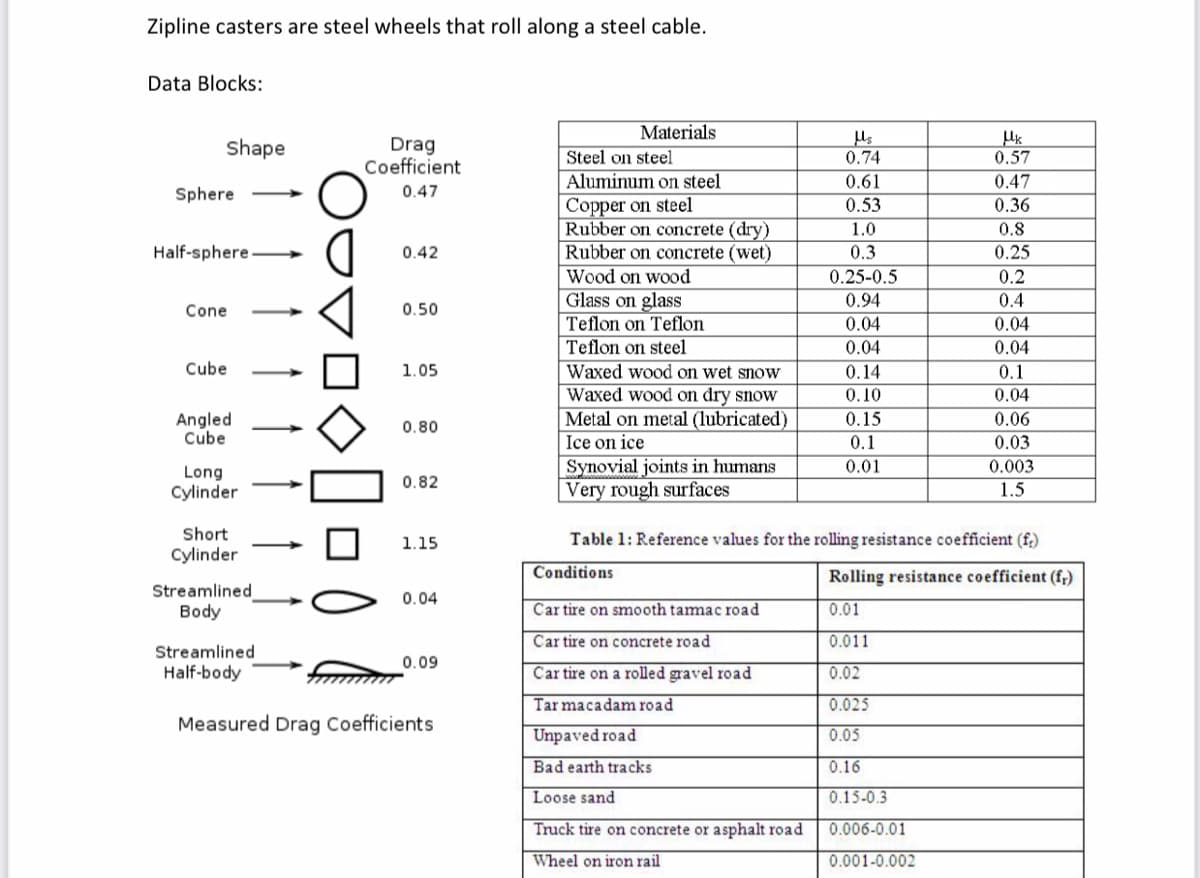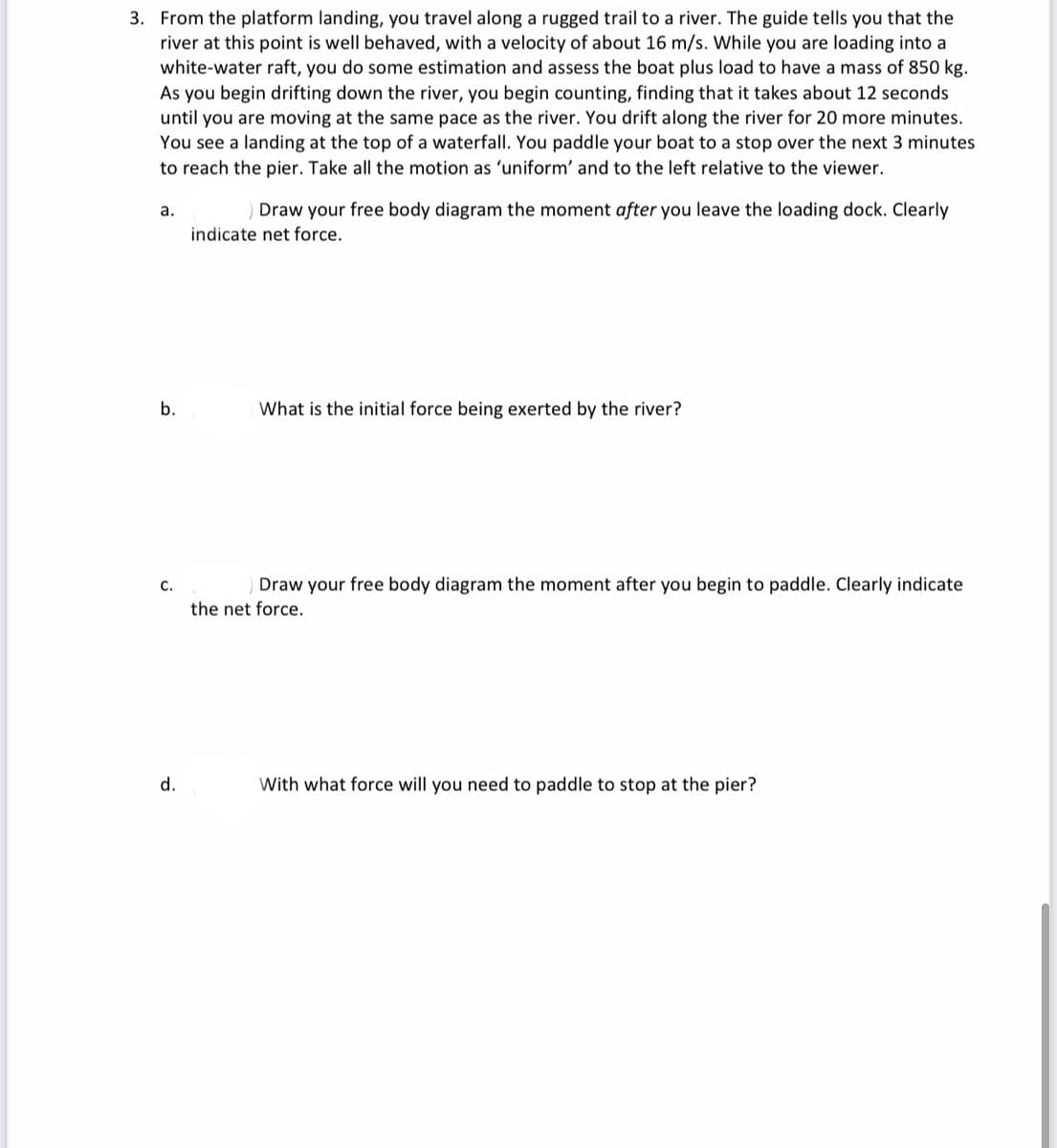Zipline casters are steel wheels that roll along a steel cable. Data Blocks: Materials Drag Coefficient Shape Steel on steel 0.74 0.57 Aluminum on steel 0.61 0.47 Sphere 0.47 Copper on steel Rubber on concrete (dry) Rubber on concrete (wet) Wood on wood Glass on glass Teflon on Teflon Teflon on steel 0.53 0.36 1.0 0.8 Half-sphere- 0.42 0.3 0.25 0.25-0.5 0.2 0.94 0.4 Cone 0.50 0.04 0.04 0.04 0.04 Cube Waxed wood on wet snow Waxed wood on dry snow Metal on metal (lubricated) Ice on ice 1.05 0.14 0.1 0.10 0.04 Angled Cube 0.15 0.06 0.80 0.1 0.03 Synovial joints in humans Very rough surfaces 0.01 0.003 Long Cylinder 0.82 1.5 Short Cylinder 1.15 Table 1: Reference values for the rolling resistance coefficient (f;) Conditions Rolling resistance coefficient (fr) Streamlined 0.04 Body Car tire on smooth tamac road 0.01 Car tire on concrete road 0.011 Streamlined 0.09 Half-body Car tire on a rolled gravel road 0.02 Tar macadam road 0.025 Measured Drag Coefficients Unpaved road 0.05 Bad earth tracks 0.16 Loose sand 0.15-0.3 Truck tire on concrete or asphalt road 0.006-0.01 Wheel on iron rail 0.001-0.002 oマロ令 3. From the platform landing, you travel along a rugged trail to a river. The guide tells you that the river at this point is well behaved, with a velocity of about 16 m/s. While you are loading into a white-water raft, you do some estimation and assess the boat plus load to have a mass of 850 kg. As you begin drifting down the river, you begin counting, finding that it takes about 12 seconds until you are moving at the same pace as the river. You drift along the river for 20 more minutes. You see a landing at the top of a waterfall. You paddle your boat to a stop over the next 3 minutes to reach the pier. Take all the motion as 'uniform' and to the left relative to the viewer. а. Draw your free body diagram the moment after you leave the loading dock. Clearly indicate net force. b. What is the initial force being exerted by the river? с. Draw your free body diagram the moment after you begin to paddle. Clearly indicate the net force. d. With what force will you need to paddle to stop at the pier?
Zipline casters are steel wheels that roll along a steel cable. Data Blocks: Materials Drag Coefficient Shape Steel on steel 0.74 0.57 Aluminum on steel 0.61 0.47 Sphere 0.47 Copper on steel Rubber on concrete (dry) Rubber on concrete (wet) Wood on wood Glass on glass Teflon on Teflon Teflon on steel 0.53 0.36 1.0 0.8 Half-sphere- 0.42 0.3 0.25 0.25-0.5 0.2 0.94 0.4 Cone 0.50 0.04 0.04 0.04 0.04 Cube Waxed wood on wet snow Waxed wood on dry snow Metal on metal (lubricated) Ice on ice 1.05 0.14 0.1 0.10 0.04 Angled Cube 0.15 0.06 0.80 0.1 0.03 Synovial joints in humans Very rough surfaces 0.01 0.003 Long Cylinder 0.82 1.5 Short Cylinder 1.15 Table 1: Reference values for the rolling resistance coefficient (f;) Conditions Rolling resistance coefficient (fr) Streamlined 0.04 Body Car tire on smooth tamac road 0.01 Car tire on concrete road 0.011 Streamlined 0.09 Half-body Car tire on a rolled gravel road 0.02 Tar macadam road 0.025 Measured Drag Coefficients Unpaved road 0.05 Bad earth tracks 0.16 Loose sand 0.15-0.3 Truck tire on concrete or asphalt road 0.006-0.01 Wheel on iron rail 0.001-0.002 oマロ令 3. From the platform landing, you travel along a rugged trail to a river. The guide tells you that the river at this point is well behaved, with a velocity of about 16 m/s. While you are loading into a white-water raft, you do some estimation and assess the boat plus load to have a mass of 850 kg. As you begin drifting down the river, you begin counting, finding that it takes about 12 seconds until you are moving at the same pace as the river. You drift along the river for 20 more minutes. You see a landing at the top of a waterfall. You paddle your boat to a stop over the next 3 minutes to reach the pier. Take all the motion as 'uniform' and to the left relative to the viewer. а. Draw your free body diagram the moment after you leave the loading dock. Clearly indicate net force. b. What is the initial force being exerted by the river? с. Draw your free body diagram the moment after you begin to paddle. Clearly indicate the net force. d. With what force will you need to paddle to stop at the pier?
Chapter2: Loads On Structures
Section: Chapter Questions
Problem 1P
Related questions
Question
All the parts please! Thank you!

Transcribed Image Text:Zipline casters are steel wheels that roll along a steel cable.
Data Blocks:
Materials
Drag
Coefficient
Shape
Steel on steel
0.74
0.57
Aluminum on steel
0.61
0.47
Sphere
0.47
Copper on steel
Rubber on concrete (dry)
Rubber on concrete (wet)
Wood on wood
Glass on glass
Teflon on Teflon
Teflon on steel
0.53
0.36
1.0
0.8
Half-sphere-
0.42
0.3
0.25
0.25-0.5
0.2
0.94
0.4
Cone
0.50
0.04
0.04
0.04
0.04
Cube
Waxed wood on wet snow
Waxed wood on dry snow
Metal on metal (lubricated)
Ice on ice
1.05
0.14
0.1
0.10
0.04
Angled
Cube
0.15
0.06
0.80
0.1
0.03
Synovial joints in humans
Very rough surfaces
0.01
0.003
Long
Cylinder
0.82
1.5
Short
Cylinder
1.15
Table 1: Reference values for the rolling resistance coefficient (f;)
Conditions
Rolling resistance coefficient (fr)
Streamlined
0.04
Body
Car tire on smooth tamac road
0.01
Car tire on concrete road
0.011
Streamlined
0.09
Half-body
Car tire on a rolled gravel road
0.02
Tar macadam road
0.025
Measured Drag Coefficients
Unpaved road
0.05
Bad earth tracks
0.16
Loose sand
0.15-0.3
Truck tire on concrete or asphalt road
0.006-0.01
Wheel on iron rail
0.001-0.002
oマロ令

Transcribed Image Text:3. From the platform landing, you travel along a rugged trail to a river. The guide tells you that the
river at this point is well behaved, with a velocity of about 16 m/s. While you are loading into a
white-water raft, you do some estimation and assess the boat plus load to have a mass of 850 kg.
As you begin drifting down the river, you begin counting, finding that it takes about 12 seconds
until you are moving at the same pace as the river. You drift along the river for 20 more minutes.
You see a landing at the top of a waterfall. You paddle your boat to a stop over the next 3 minutes
to reach the pier. Take all the motion as 'uniform' and to the left relative to the viewer.
а.
Draw your free body diagram the moment after you leave the loading dock. Clearly
indicate net force.
b.
What is the initial force being exerted by the river?
с.
Draw your free body diagram the moment after you begin to paddle. Clearly indicate
the net force.
d.
With what force will you need to paddle to stop at the pier?
Expert Solution
This question has been solved!
Explore an expertly crafted, step-by-step solution for a thorough understanding of key concepts.
Step by step
Solved in 7 steps with 2 images

Knowledge Booster
Learn more about
Need a deep-dive on the concept behind this application? Look no further. Learn more about this topic, civil-engineering and related others by exploring similar questions and additional content below.Recommended textbooks for you


Structural Analysis (10th Edition)
Civil Engineering
ISBN:
9780134610672
Author:
Russell C. Hibbeler
Publisher:
PEARSON

Principles of Foundation Engineering (MindTap Cou…
Civil Engineering
ISBN:
9781337705028
Author:
Braja M. Das, Nagaratnam Sivakugan
Publisher:
Cengage Learning


Structural Analysis (10th Edition)
Civil Engineering
ISBN:
9780134610672
Author:
Russell C. Hibbeler
Publisher:
PEARSON

Principles of Foundation Engineering (MindTap Cou…
Civil Engineering
ISBN:
9781337705028
Author:
Braja M. Das, Nagaratnam Sivakugan
Publisher:
Cengage Learning

Fundamentals of Structural Analysis
Civil Engineering
ISBN:
9780073398006
Author:
Kenneth M. Leet Emeritus, Chia-Ming Uang, Joel Lanning
Publisher:
McGraw-Hill Education


Traffic and Highway Engineering
Civil Engineering
ISBN:
9781305156241
Author:
Garber, Nicholas J.
Publisher:
Cengage Learning